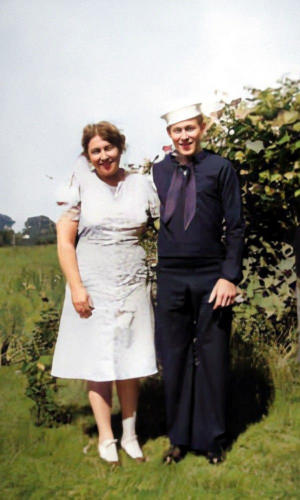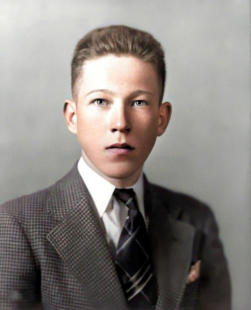
copyright © Wartime Heritage Association 2012-2024
Website hosting courtesy of Register.com - a web.com company
Wartime Heritage
ASSOCIATION
Remembering World War II
Name:
Philip Douglas Quinlan
Rank:
Seaman First Class
Service Number:
2018573
Service:
USS Juneau (CL-52), US Navy
Awards:
Purple Heart
Date of Birth:
March 3, 1922
Place of Birth:
Peabody, Essex County, Massachusetts
Date of Enlistment:
December 27, 1940
Place of Enlistment:
Massachusetts
Address at Enlistment:
Peabody, Essex Co., Mass.
Age at Enlistment:
18
Occupation:
Student
Marital Status:
Single
Next of Kin:
John Henry Quinlan (Father)
Date of Death:
November 13, 1942
Age:
20
Cemetery:
Manila American Cemetery
Reference:
Walls of the Missing
Philip Douglas Quinlan was the son of John Henry Quinlan (1890-1968)
Martha M (Matheson) (1898-1988). His mother was born in
Whycocomagh, Inverness County, in Cape Breton, Nova Scotia. His
father was born in Peabody, Massachusetts. His parents met while
working at the AC Lawrence Leather Co. factory in Peabody and raised
their family of five children on Linden Road in South Peabody, Mass.
Philip had one brother and three sisters - Richard Henry Quinlan
(1923–1936), Geraldine Anne Quinlan (1921–1987), Martha Elizabeth
Quinlan (1924–2001), and Miriam A. (Quinlan) Towey (born 1933).
Philip completed his third year of high school in the spring of 1940
with his favorite subject being history and an ambition to be a
machinist according to his yearbook. His sister Miriam remembers that
her brother loved horses and probably would have worked on a farm,
but there were no jobs available when he graduated from Peabody
High School in 1940, so he joined the US Navy, in December 1940.
Philip served on the USS Texas (BB-35), a New York-class battleship, from April 25, 1941, until he was
transferred to the USS Juneau (CL-52), an Atlanta-class light cruiser, on March 4, 1942.
After a hurried shakedown cruise along the Atlantic Coast in the spring of 1942, Juneau assumed blockade
patrol in early May off Martinique and Guadeloupe Islands to prevent the escape of Vichy French naval units. She
returned to New York to complete alterations and operated in the North Atlantic and Caribbean from June 1st to
August 12th on patrol and escort duties.
The cruiser departed for the Pacific Theater on August 22, 1942. After stopping briefly at the Tonga Islands and
New Caledonia, she rendezvoused on September 10th with Task Force 18 (TF 18) under the command of Rear
Admiral Leigh Noyes, flying his flag on Wasp. The following day, TF 17, which included Hornet, combined with
Admiral Noyes' unit to form TF 61, whose mission was to ferry fighter aircraft to Guadalcanal. On September
15th, Wasp took three torpedo hits from the Japanese submarine I-19, and, with fires raging out of control, was
sunk at 2100 by Lansdowne. Juneau and screen destroyers rescued 1,910 survivors of Wasp and returned them
to Espiritu Santo, New Hebrides, on September 16th. The next day, the fast cruiser rejoined TF 17. Operating
with the Hornet group, she supported three actions that repelled enemy thrusts at Guadalcanal: the Buin-Faisi-
Tonolai Raid; the Battle of the Santa Cruz Islands; and the Naval Battle of Guadalcanal (Third Savo).
The USS Juneau, June 1, 1942 (from the Bureau of Ships Collection in the U.S. National Archives #19-N-31264)
On November 8, 1942 Juneau departed Nouméa, New Caledonia, as a unit of TF 67 under the command of Rear
Admiral Richmond K. Turner to escort reinforcements to Guadalcanal. The force arrived there early morning on
November 12, 1942, and Juneau took up her station in the protective screen around the transports and cargo
vessels. Unloading proceeded unmolested until 14:05, when 30 Japanese planes attacked the alerted United
States group. The AA fire was effective, and Juneau alone accounted for six enemy torpedo bombers shot down.
The few remaining Japanese planes were, in turn, attacked by American fighters; only one bomber escaped.
Later in the day, an American attack group of cruisers and destroyers cleared Guadalcanal on reports that a
large enemy surface force was headed for the island. At 01:48 on November 13, 1942, Rear Admiral Daniel J.
Callaghan's relatively small landing support group engaged the enemy. The Japanese force consisted of two
battleships, one light cruiser, and nine destroyers.
Because of bad weather and confused communications, the battle occurred in near-pitch darkness and at almost
point-blank range, as the ships of the two sides became intermingled. During the melee, Juneau was struck on
the port side by a torpedo launched by Japanese destroyer Amatsukaze, causing a severe list, and necessitating
withdrawal. Before noon on November 13th, Juneau, along with two other cruisers damaged in the
battle—Helena and San Francisco—headed toward Espiritu Santo for repairs. Juneau was steaming on one screw,
keeping station 800 yd (730 m) off the starboard quarter of the likewise severely damaged San Francisco. She
was down 12 feet (3.7 m) by the bow, but able to maintain 13 kn (15 mph, 24 km/h).
A few minutes after 11:00, two torpedoes were launched from Japanese submarine I-26. These were intended
for San Francisco, but both passed ahead of her. One struck Juneau in the same place that had been hit during
the battle. There was a great explosion; Juneau broke in two and disappeared in just 20 seconds.
Seaman First Class Philip Douglas Quinlan was lost along with 686 men in the sinking of the Juneau.
Approximately 100 survived the initial sinking, but only 10 were recovered from the sea after waiting 8 days for
rescue search aircraft or ships to arrive.
Lost at sea, Philip has no grave but is remembered on the Walls of the Missing at the Manila American Cemetery
in the Philippines. He also has a memorial marker at the Arlington National Cemetery in Arlington County,
Virginia, and his name appears on his family grave marker at the Cedar Grove Cemetery in Peabody,
Massachusetts.
A memorial to the USS Juneau and her crew sits on the Seawalk on South Franklin Street in Juneau, Alaska; the
ship’s namesake.
The wreck of Juneau was located on March 17, 2018. by Paul Allen's research crew on board RV Petrel. The
cruiser rests 4,200 m (13,800 ft) below the surface off the Solomon Islands in several large pieces.
Philip Douglas Quinlan


Sources:
American Battle Monuments Commission – Philip D. Quinlan
American Battle Monuments Commission – Manila American Cemetery
findagrave - Arlington
findagrave - Peabody
findagrave - Manila
Salem News





- World War I - Menu
- WWI Stories and Articles
- Photos - Yarmouth Soldiers
- Selection of World War I Songs
- WWI Casualties of Yarmouth, NS
- Those Who Served - Yarmouth, NS
- WWI Casualties Digby Co. NS
- WWI Casualties Shelburne Co. NS
- Merchant Mariners (1915) Yarmouth, NS
- Canadian Forestry Corps - Non Yarmouth Birth/Residence Enlistments
- US Draft Registry - Yarmouth NS Born


- World War II - Menu
- WWII Stories and Articles
- Telegraphist Air Gunners
- WWII Casualties of Nova Scotia
- US Casualties with NS Connection
- Far East/Pacific Casualties with NS Connection
- Merchant Navy Casualties Nova Scotia
- Nova Scotia WWII Casualties Holten Canadian War Cemetery
- D-Day Casualties - Nova Scotia
- CANLOAN Program Casulaties - Nova Scotia
- Battle of the Bulge Casualties - Nova Scotia
- WWII Casualties Yarmouth NS
- Yarmouth Casualties - RCAF RAF Canadian Army WWII
- Yarmouth Co., Marrages WWII
- Casualties Non-Born/Residents with Connection to Yarmouth Co., Nova Scotia.
- WWII Casualties Digby Co., NS
- Non-Nova Scotian WWII Casualties Buried in Nova Scotia
- WWII RCAF Casualties Aged 16-18
- Brothers/Sisters Who Served - World War II













